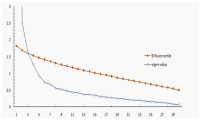PURPOSE This study aimed to develop a Korean version of the Low Energy Availability in Females Questionnaire (LEAF-Q) by translating the original English version into Korean using cross-cultural translation guidelines and conducting a face validity assessment. METHODS Following structured cross-cultural translation guidelines, a provisional final version (Pre-K-LEAF-Q) was created through initial translation, synthesis of initial translations, back translation, synthesis of back translations, and expert committee review. Additionally, its face validity was tested with 30 female participants. RESULTS After completing the translation process, the expert committee comprehensively compared each translation to finalize the Pre-K-LEAF-Q. This version was crafted to ensure semantic, idiomatic, experiential, and conceptual equivalence. Among the 30 females who participated, three noted that certain phrases were unclear or awkwardly expressed. The expert committee reviewed these five comments from the face validity test and modified three of the phrases. CONCLUSIONS The K-LEAF-Q was developed through cross-cultural translation and face validity testing to suit the cultural and linguistic context of Korea. It is expected to be a valuable tool for Korean female athletes.
Purpose The purpose of the study was to determine difference of body composition, bone mineral density and health-related fitness by physical activity level in young women. Methods A total of 90 women aged 19-29 years participated in this study. The subjects were divided into three groups (low, middle, and high level) according to the physical activity level estimated by bone-specific physical activity questionnaire(BPAQ). Body height and weight were measured. Body composition parameters including four sites of bone mineral density(BMD) were estimated by DXA (Hologic, QDR-4500, USA). Health-related fitness tests was assessed using sit & reach, grip strength, sit-ups, and VO2max. Statistical analysis was performed using SAS version 9.4. All data were presented in terms of means and standard deviations. One-way ANOVA was applied to determine difference of dependent variables by physical activity level. Duncan's multiple range test was used as a post-hoc test. The statistical significance level was set at p < .05. Results There were significant differences on body weight(F = 4.867, p = .01), body mass index(F = 5.053, p = .008) and fat-free mass(F = 8.364, p = .0001) among the three groups. Significant differences were found on whole body BMD(F = 16.730, p = .0001), lumbar BMD(F = 11.480, p = .0001), femur BMD(F = 42.182, p = .0001) and forearm BMD(F = 5.560, p = .005) among the three groups. There were also significant differences on sit and reach(F = 11.433, p = .0001), sit-ups(F = 17.972, p = .0001), VO2max(F = 3.106, p = .05) and duration of GXT(F = 7.479, p = .001). Conclusions There were differences on body composition, bone mineral density and health-related physical fitness by physical activity levels. Nevertheless, the questionnaire used in this study was not able to judge participation in various exercise types including aerobic exercise or resistance exercise. Therefore, in the future study, longitudinal study considering various types of physical activity and dietary intake will be needed.
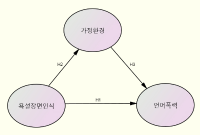
The purpose of this study is to analyse that the college students' recognition on abuse scene of sport broadcasting influences verbal violence. The subjects were college students in P municipality and this study distributed 230 questionnaires among them. And 203 questionnaires were collected except some questionnaires that didn't fill in them properly. To analyze them, this study used SPSS Win 20.0 and AMOS 20.0 and came to a conclusion as follows. First, the College students' negative recognition on abuse scene of sport broadcasting had negative influences on verbal violence. Second, home environment wasn't affected by the college students' negative recognition on abuse scene of sport broadcasting. Third, the verbal violence also wasn't much effected by the home environment of the college students. Finally, the home environment didn't intervene in the relationship between the college students' recognition on abuse scene of sport broadcasting and the verbal violence. Therefore this study considers that the abuse scene in the game on the live broadcasting needs to apply sanction properly by a broadcasting station for TV viewers, although the college students with a higher negative understanding of this abuse scene use less verbal violence.




The current study aimed to examine behavioral intentions of online sports products consumers using the Extended Goal-directed Behavior Model. The questionnaires were distributed to consumers who had experience of purchasing sports products online. Data collected from 282 respondents were analyzed mainly using structural equation modeling. The results were as follows: First, attitude and subjective norm had a positive effect on desire. Second, perceived behavior control did not affect desire but had a positive effect on behavior intention. Third, positive anticipated emotions had a positive effect on desire and negative anticipated emotions had a negative effect on desire. Fourth, prior knowledge did not affect desire and behavior intention. Fifth, frequency of past purchase behavior did not affect desire, but had a positive effect on behavior intention. Lastly, desire had a positive effect on behavior intention.



Purpose The purpose of this study was to evaluate the moderate to vigorous physical activity(MVPA) and sedentary time measured by accelerometer. Furthermore, the level of physical activity and adherence rate of physical activity guideline(PAG) were compared with the self-reported questionnaire. Methods The MVPA, sedentary time, and adherence rate of PAG according to age and sex were examined to people who agreed to wear accelerometers among the participants of the 2014-2015 Korea National Health and Nutrition Examination Survey. To compare the relationship between accelerometer and self-reported questionnaire, Chi-squared test and Spearman correlation analysis were performed. Results The MVPA of the accelerometer-total(AT) was 40.6 minutes/day for men and 31.1 minutes/day for women. Sedentary time was 502.9 minutes/day for men and 498.9 minutes/day for women. The MVPA of accelerometer-bout(AB) estimates was 16.4 minutes/day for men and 14.2 minutes for women. On the other hand, the MVPA of the self-report was 95.8 minutes for men and 64.3 minutes for women, and the sedentary time was 471.2 minutes for men and 455.2 minutes for women. The adherence rate of PAG was 55.6% of the self-report, 56.1% of the AT, and 21.4% of the AB. The correlation between self-report and accelerometer was statistically significant(p < 0.01), but showed a weak correlation coefficient(rho=0.112-0.351). There was no association between AB and self-report(p < 0.01). The sensitivity and specificity of the self-report were 71.3% and 48.6%, respectively. The positive and negative predictive values of the self-report were 27.5% and 86.1%, respectively. Conclusions As a result of this study, self-reported physical activity level by questionnaire had more MVPA and less sedentary time than the accelerometer-determined physical activity. In addition, the adherence rate of the PAG differed from accelerometer and self-report. The difference was significantly increased when comparing AB with the self-report. Therefore, great care must be taken when interpreting accelerometer and self-report questionnaire. Further research will be needed on specific methods that can be used by complementing the two measurement tools.
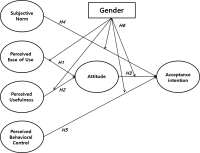
Purpose The current study was aimed to examine acceptance intention of sports wearable smart device using the Technology Acceptance Model and Theory of Planned Behavior. Methods Data were drawn from 357 consumers who had experience purchasing sports products. Data were analyzed through frequency analysis, reliability analysis, confirmatory factor analysis, correlation analysis, and structural equation modeling using SPSS 20.0 and AMOS 20.0 program. Results First, perceived ease of use had a positive effect on attitude. Second, perceived usefulness had a positive effect on attitude. Third, attitude had a positive effect on acceptance intention. Fourth, subjective norm had a positive effect on acceptance intention. Fifth, perceived behavioral control did not affect acceptance intention. Sixth, differences of path coefficients between attitude and acceptance intention, subjective norm and acceptance intention were significant according to gender. Conclusion The significance of this research is to provide the basis of positioning strategy for domestic companies of sports wearable smart device.


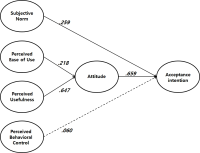
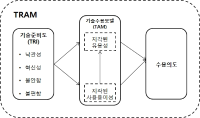
The current study was aimed to examine acceptance intention of sports Wearable products using the Technology Readiness and Acceptance Model. Data were drawn from 271 consumers in their 20s and 30s. Data were analyzed through frequency analysis, exploratory factor analysis, confirmatory factor analysis, reliability analysis, correlation analysis, simple regression analysis and multiple regression analysis using SPSS 20.0 and AMOS 20.0 program. The results were as follows: First, optimism had a positive effect on perceived usefulness but innovativeness, discomfort and insecurity did not affect perceived usefulness. Second, optimism and innovativeness had a positive effect on perceived ease of use and discomfort had a negative effect on perceived ease of use but insecurity did not affect perceived ease of use. Third, perceived ease of use had a positive effect on perceived usefulness. Fourth, perceived usefulness and perceived ease of use had a positive effect on acceptance intention.

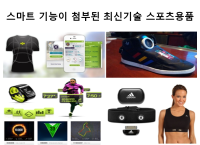
This study was to identify the perception on retirement for professional soccer players as a basic study for the development of career transition program, Professional soccer K-League(K-League Classic, K-League Challenge), N-League(Club League), K3-League(Challenger League) league players registered in 2013 were selected as a population. Structured questionnaire surveys were utilized for the research, total of 1000 questionnaires(250 per league) were distributed and gathered. Final sample of 548 questionnaires were analyzed excluding people which do not respond properly. SPSS was used to identify the characteristics of the responder in frequency analysis. One-way ANOVA was used to find the difference in retiring causes among the leagues, Pearson Correlation analysis was used to examine the correlations among the variables. Multiple regression analysis was used to find the effect of economic and psychological preparation on plans after retirement. The results were as follows. First, among the causes of retirement, 'contract suspended', 'seek other life', 'family issues such as marriage' showed the difference in perception of retirement according to the leagues. Second, psychological preparation was more focused than economic preparation to prepare for retirement planning among players, respectively.
PURPOSE This study aimed to investigate conditioning management and perception in Korea Ladies Professional Golf Association golfers and elite amateur female golfers. METHODS Physical characteristics and performance-related factors were investigated through a short version of the conditioning questionnaire consisting of 16 questions on five factors, surveying 129 female professional golfers and 174 elite amateur female golfers. The components of the questionnaire included physical fitness (four questions), injury (four questions), nutrition (three questions), mental (three questions), and performance strategy factors (two questions). Data were analyzed using IBM SPSS Statistics ver. 23.0 (IBM Co., Armonk, NY, USA). An independent t-test was used for comparison between groups. RESULTS Physical fitness-related factors showed significant differences in all four questions between groups (p<0.001–0.031), injury-related questions showed significant differences between groups in three questions (p<0.001–0.003), and one nutrition-related question was different between groups (p<0.001). CONCLUSIONS Differences were seen in conditioning management factors recognized between professional and elite amateur female athletes. Future research on conditioning questions and differences in effects according to actual performance will be needed.
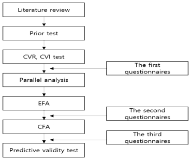
The purpose of this study was to develop an instrument that measures participantsʼ satisfaction in sports instructor training programs. The instrument development process includes focus group interviews, parallel analysis, and validity and reliability tests. Data were collected from 897 participants from three regular training sessions and were analyzed primarily using SPSS and MPlus software. The results indicated that the service satisfaction of sport instructor programs has an underlying three sub-factors, including ʻadministrative supportʼ, ʻcurriculum contentsʼ, and ʻlearning environmentʼ. This study can provide helpful information to managers in improving their respective sport instructor training programs.

